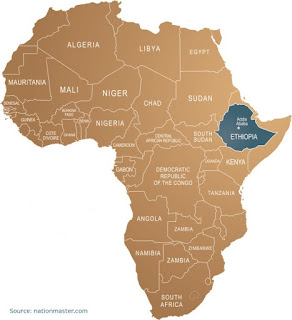Are The Tables Turning?
Last week I discussed irrigation as the primary way in which Egypt employs its available water resources (The River Nile) for food production. The Nile is evidently an instrumental part of Egypt’s food security. Interestingly, 86% of the water being used for irrigation in Egypt actually originates in Ethiopia, a perverse irony that, as I’ve previously highlighted, leaves Ethiopia with chronic food insecurity. The majority of this water comes from the Blue Nile, a river which travels 1000 kilometres through Ethiopia, largely untouched and certainly under-utilised, before eventually reaching Egypt. Figure 1 broadly illustrates this progression of water from Ethiopia to Egypt, diminishing significantly once it flows outside of Ethiopia’s borders (it is important to recognise that although agriculutral extraction is important, it is not the sole cause of this, there is a host of contributing factors such as groundwater recharge, evaporation and industrial use). Ultimately although Egypt contributes no water to the river from which it survives, it needs every last litre.
 |
| Figure 1: Schematic representation of the water entering the Nile River Basin as precipitation in comparison to the total outflow into the Mediterranean Sea. The outflow to inflow ratio is 1.7%. Please note, political boundaries and recently formed South Sudan are not correctly outlined on this map. |
The precipitation cycles and changes taking place within Ethiopia (see these previous two posts if you’d like to know more about these fluctuations) strongly influence the water availability and crop cycles in Egypt. For example, the rainfall that comes during the June-September Kiremt thus not only provides for Ethiopian agriculture, but also sustains much of Egypt’s irrigation. The key difference, as I explored last week, is that Ethiopia relies primarily on rain-fed agriculture, therefore allowing Egypt to use such large quantities of water for irrigated food production. Similarly, a prolonged period of reduced rainfall in Ethiopia not only threatens Ethiopia’s national food security but Egypt’s as well.
In light of this heavy reliance on Ethiopia’s lack of exploitation of its water resources, it is hardly surprising that as Ethiopia nears completion of the Grand Ethiopian Renaissance Dam (GERD) Egypt’s feathers are becoming increasingly ruffled. Once finished, the GERD will become the largest hydroelectric plant in Africa, costing around $4.1 billion, and will store up to 74 cubic kilometres of water. To put this in perspective, Egypt currently uses around 55.5 cubic kilometres of water each year. Therefore the dam, whilst not to be used for the expansion of Ethiopian irrigation, could have serious implications for downstream irrigation and, according to the Egyptian government, could plunge them into food insecurity. Worryingly, a study from a Cairo University professor has estimated that if Ethiopia attempted to fill the GERD within three years, Egypt would lose 51% of its farmland. In truth, no-one really knows what the true impacts of the GERD will be on Egyptian agriculture, although the questions it raises over the riparian rights are extensive and interesting.
I would love to continue my discussion on the potential physical, human and geopolitical impacts of the Grand Ethiopian Renaissance Dam but unfortunately, as it is unlikely to effect Ethiopia’s food security beyond stimulating economic growth, I must turn my attention back towards Ethiopia and it’s own food production. The GERD has, however, illustrated the potential of blue-water focused engineering in utilising potential water supplies and has got me wondering about other forms of blue-water engineering that could be introduced within Ethiopia to increase food production. In my next post I’ll therefore be exploring the opportunities for Ethiopia to extract groundwater and its potential for increasing the area of irrigated land.
I hope you’ve enjoyed my brief foray into transboundary water conflicts. I know it hasn’t been totally relevant to my blog on Ethiopia’s water and food, but it’s certainly an interesting area and draws attention to the fact that solutions in one country may pose problems for another. See you next week!



Comments
Post a Comment